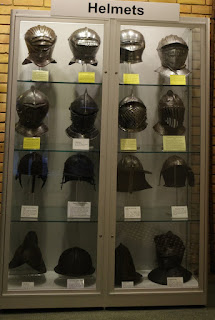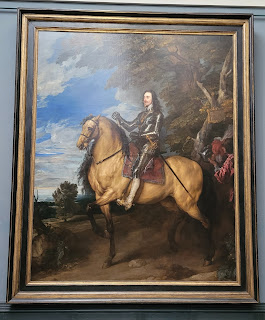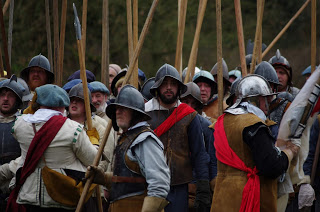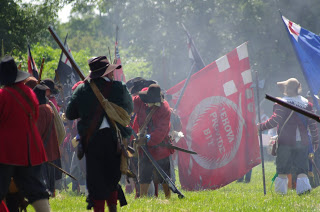Seventeenth century Kent, despite its proximity to London, was a bit of a rural backwater. Roads were bad, and often impassable; the local gentry, in comparison to the rest of the country, were relatively impoverished.
Whilst England's system of local 'government' was based upon hundreds, Kent was different being organised by "lathes". A system unique to Kent believed to date to the Kingdom of the Kentish (which existed until the 9th Century). See here for a brief description of the county's trained bands.
Kent was a deeply divided county in the Civil War; although nominally under Parliamentary control, there were Royalist risings in Tonbridge and Sevenoaks in 1643, Canterbury in 1647 and a major uprising in 1648, culminating in the Battle of Maidstone.
July 1643 a force of about 4,000 Royalists, from Tonbridge, Sevenoaks and Faversham had assembled at Sevenoaks. In response Parliament sent a force from London consisting of 1,800 troops and two troops of Horse, led by Colonel Richard Browne. After a failed negotiation at Sevenoaks, the Royalists retreated towards Tonbridge, where on July 24th they made a stand.
Parliament's advance was initially met by sniper fire from men hidden in the woods and hedges, upon attacked the Royalist lines which soon broke. The Royalists fled into Tonbridge, where 200 were captured. The rest fled to Yalding, pursed by the Parliamentarian cavalry, where they put up a final stand. Now numbering just 600 men, those that did not flee in the night, surrendered on the morning of the 25th.
Canterbury was home to the 1647 Plum Pudding Riots; the local response to Cromwell Parliament 'cancelling' Christmas*. Shopkeepers rose up when pressed by the mayor to open their shops on Christmas Day 1647. The Kent County Committee was ordered to call out the trained bands to suppress the rising. Attempts to prosecute the ring leaders of the riots came to nought, but the seeds of discontent had been sown. They would continue to grow spilling out into major bloodshed in 1648.
The simmering political situation led to a major Royalist uprising in the County in late spring 1648, when the New Modelled Army was called upon to put down unrest and a petition calling for the return of Charles II. Canterbury, Rochester, Sittingbourne, Faversham and Sandwich were seized by Royalist insurgents on 21 May 1648.
This, by now, open revolt was put down by the New Modelled Army led by Sir Thomas Fairfax. Once the main force of the uprising had been quashed, Colonel Nathaniel Rich was sent to retake Dover and the castles taken by the Royalists. Fairfax would turn north in pursuit of the substantial Royalist numbers who has escaped from the battle at Maidstone, eventually seeking shelter in
Colchester.
So what is there for the ECW tourist to see in the garden of England?
The rather imposing Rochester Castle was taken for Parliament by Colonel Sandys in 1642, his garrison were not bothered at all during the hostilities. Cared for by English Heritage there is little to show that the Civil Wars troubled this part of the country.
 |
| Tonbridge gatehouse |
During the 1643 fighting Royalists unsuccessfully attempted to seize the derelict Tonbridge Castle. Once the rising had been dealt with, Parliament ordered it to be sleighted. Cared for by the local council only the gatehouse and mound remain of the Castle. A late eighteenth century mansion dominates the site.
Hilden Bridge which saw fierce fighting in 1643 was replaced long ago by a more modern structure.
 |
| The entrance to Dover Castle |
Dover Castle declared for the King at the outbreak of hostilities. Not long after a small group of locals scaled the walls, overcame the sentries and forced the small garrison to surrender. The Castle would be besieged during the Royalist uprising of 1648. The besiegers quickly retreated when Colonel Rich arrived with a small force to relieve the siege. Cared for by English Heritage, Dover Castle is presented as a medieval fortress and also as its important role during the Second World War. Sir William Waller's father, Sir Thomas Waller, was a lieutenant of Dover Castle.

Canterbury Cathedral suffered at the hands of Puritans (not as the tour guides insist 'Cromwell's men') who smashed whatever they deemed to be Papist idolatry. The rather beautiful font was smashed, but reinstated during the Restoration. Much of the medieval stained glass would be smashed and horses were allegedly stabled in the south nave. A large statue of Christ on the gateway to the Cathedral was destroyed, the statue now residing upon the gateway is a replacement.

Walmer Castle was seized during the uprising, and the Parliamentarian Colonel Rich was sent to retake it. A mortar was called up, when it eventually arrived, there was no engineer to oversee its firing. Once it became apparent that the Kent Rising did not have widespread support within the country, the Royalists surrendered (taking repeated hits from a siege mortar probably helped their decision making). Rather than sleighting the castle, Parliament ordered its repair and regarrisoning. Cared for by English Heritage expect tearooms, gift shop, beautifully manicured gardens, and what is best described as a stately home interior.
Once Rich had taken Walmer, he, and his forces moved onto Deal Castle. This time he had two cannon, and two demi-cannon with which to batter the Castle into submission. The garrison held out for three weeks before they surrendered. The Castle suffered much destruction but would be repaired and refortified. Also cared for by English Heritage, the siege is retold with information boards.
Walmer, Deal and Sandown Castles were built during the reign of Henry VIII; and incorporated the new technology of cannons in their defences. It is worth viewing Walmer and Deal using satellite mapping apps as their layout is stunning, and is best appreciated from the above.
Sandown Castle was also taken during the 1648 uprising, and recaptured by Rich. The Castle fell into disrepair and was demolished in the 1860s. The ruins are free to visit.
 |
| East Farleigh Bridge |
Maidstone saw the biggest encounter in the County. The Uprising was centred upon the town, and it is where Fairfax met Norwich's men. Norwich's men were poorly trained and ill equipped to take on the New Modelled Army. Fighting began as a series of skirmishes in East Farleigh where Fairfax crossed the Medway; fighting then moved onto Penenden Heath, followed by brutal street battles fought house to house towards Gabriels Hill, then Week Street before a last stand St Faith’s Churchyard.
 |
| All Saints |
What's there now?
The medieval bridge at East Farleigh is still standing. Penenden Heath has become a suburb of Maidstone, although a large park exists upon what was the heathland. Gabriels Hill and Week Street have become shopping streets. Those men who were captured during the battle were imprisoned at All Saints Church.
There are a number of buildings still standing that witnessed the battle: most notably on Bank Street.
There is a plaque commemorating the battle in what is now Brenchley Gardens (formerly St Faith's churchyard - St Faith's is still standing). The memorial is just to the side of Maidstone Museum.
Other battle of Maidstone plaques appear on the side of the town hall (Bank Street); and on the left hand side of the steps leading up to Fremlin Walk at Havoc Square (directly opposite the entrance to Maidstone Museum).
Regicide Andrew Broughton lived at a house on Earl Street (now 31-33).
 |
| Maidstone Museum |
Maidstone Museum has a small exhibit documenting the battle, with a zischagge, pot helmet and breast plate on display in the local history gallery. The museum is housed in a Tudor manor house known as Chilington Manor.
 |
Leeds Castle's Inner courtyard
|
Leeds Castle, somewhat confusingly is not in Yorkshire, but 7 miles from Maidstone. Leeds is a quintessential castle, with a moat. The Castle has a number of Civil War artefacts on display, and also a collection of seventeenth century crockery.
 |
| Cuirassier armour |
 |
| Buff coat, claimed to have been worn by Black Tom at Maidstone |
🚨
Moated manor house klaxon 🚨 Regular readers (hello all eight of you) will be aware that I have a bit of a soft spot for moated manor houses, well be still my beating heart!
Igtham Mote, cared for by the National Trust, is a fourteenth century manor house which retains many of its original features, located some 3 miles from the centre of Sevenoaks.
Whilst the house is presented in what can only be described as a Victorian style of 'this is what old houses should look like', dotted around the property are a number of interesting pieces of Civil War militaria: there are a number of harquebusier sets, and a mish mash of helmets and armour.
Nearby St Peter's Church, in Igtham, houses a memorial to Sir William Selby, and his father (also Sir William). Sir William (junior) was the owner of Igtham Mote, and died in 1638. Both he and his father are shown wearing cuirassier armour.
Knole is the birthplace of Sir William Waller. Cared for by the National Trust, the house is a former archbishop's palace. As a National Trust property expect deer, and a dear café and gift shop.
At the outbreak of War rumours circulated that the Earl of Dorset, Edward Sackville, had stockpiled arms and powder in the house. In August 1642 Parliament sent three troops of horse to seize the weapons. Dorset was away at the time, his cousin Sir John Sackville was resident. When parliament's men arrive Sir John was in church; the soldiers waited outside the church until the service was over before arresting him and sending him to Fleet Prison. Parliament's men took a way five carts of weapons, although Dorset's steward records that the weapons were ancient and not much use.
The house is home to a superb collection of Stuart furniture and portraiture, including what is believed to be the precursor to the modern sofa - The Knole Sofa. There are a number of portraits of interest including a Van Dyck of Newport and Goring, and a number of portraits of a young Charles II.
The Kings Arms in Meopham is believed to have hosted King Charles I for the night. Local legend (that phrase again) tells a story of the landlord being hung by Parliament's men for refusing to take the pub sign down; bit of a problem there, as I doubt that the pub being called the Smiths Arms caused any offence to either side of the warring divide. The pub would be renamed the Kings Arms after the Restoration.
Now an entry which might provoke angst and a rekindling of the ancient Sussex/Kent rivalry.
The Wealden Downs were an important source of iron ore. As a result a number of foundries sprang up to use the ore.
 |
| Gun and Spitroast |
The Gun and Spitroast pub in Horsmonden was the likely business headquarters of the gun founder John Browne. Browne was the King's Gunfounder to James I, and Charles through to the outbreak of hostilities. Horsmonden owes much to Browne's business: Furnace Lane leads from the centre of the village to Furnace Pond. The pond was created to power the furnace hammers. It is located away from the centre of the village because the furnace burned seven days a week, and the Brownes did not want to incur the wrath of the church. There were also a number of furnaces operated by the Brownes in the neighbouring village of Brenchley. The Horsmonden foundaries employed nearly 200 people, the flames from the furnaces were claimed to be visible ten miles away
* Parliament didn't exactly 'ban' Christmas, they legislated to make it a normal day with a side order of private devout religious observance, rather than a full blown hedonistic mid-winter knees up. And no, it wasn't Cromwell, it was the Puritans who held sway in Parliament, that 'banned Christmas'.
Postcodes for SatNavs
Rochester Castle, Rochester ME1 1SW
Tonbridge Castle, Tonbridge TN9 1BG
Hilden Bridge, Tonbridge TN10 3DA
Dover Castle, Dover CT16 1HU
Canterbury Cathedral CT1 2EH
Walmer Castle, Deal CT14 7LJ
Deal Castle, Deal CT14 7BA
































A most enjoyable morning coffee read, thank you for that. I live in Rochester so the castle is very familiar as it dominates the lovely High Street but there's a few things there in Maidstone that I was unaware of and will look out for next time I'm there.
ReplyDeleteThanks for the kind words Lee: compliments from a Kentish man about my entry on Kent - I'll settle for that. As you aren't the first to say my blog entries go down well with a morning cup of coffee... if only I did adverts
Delete